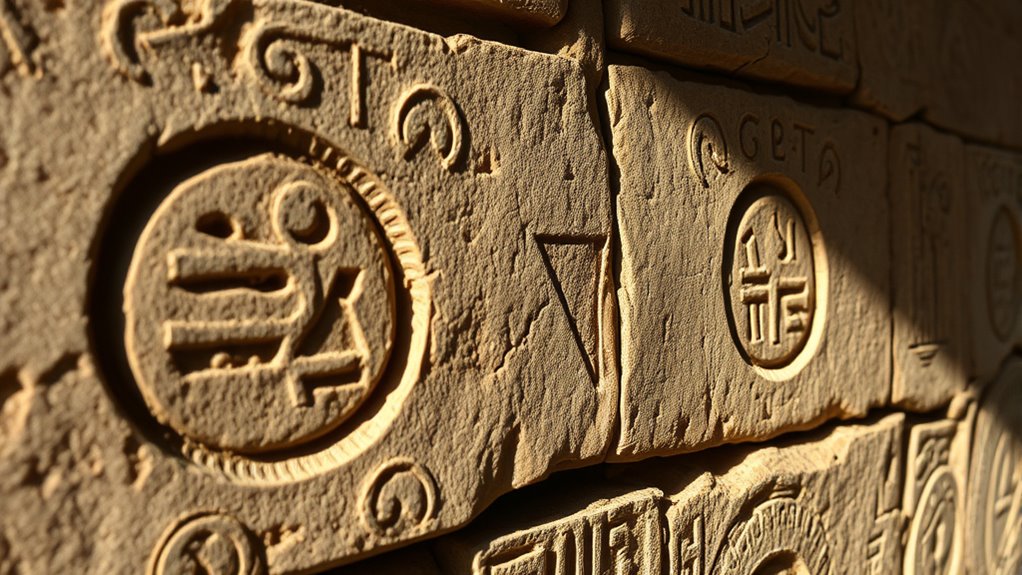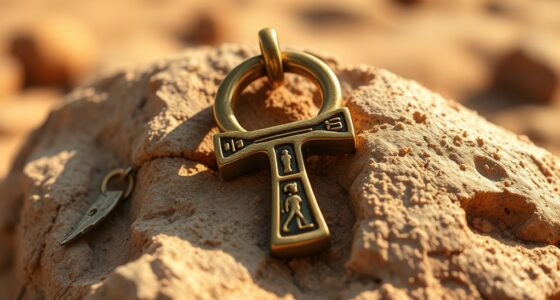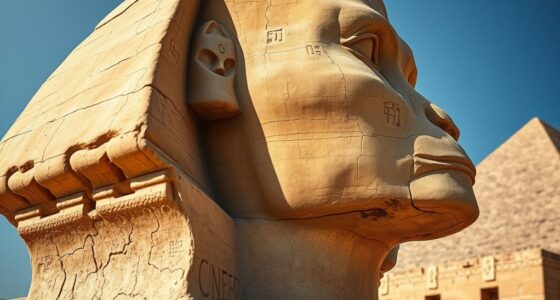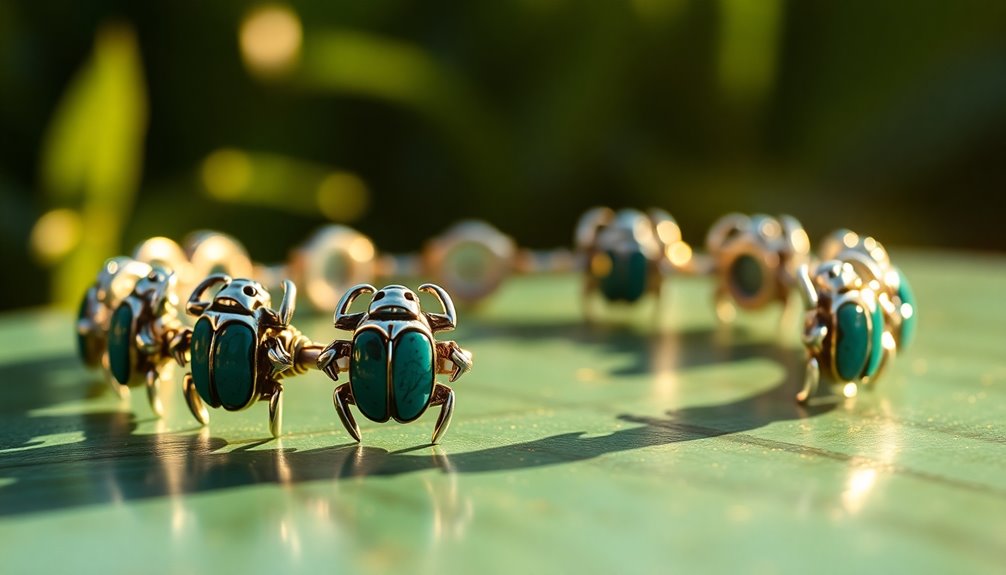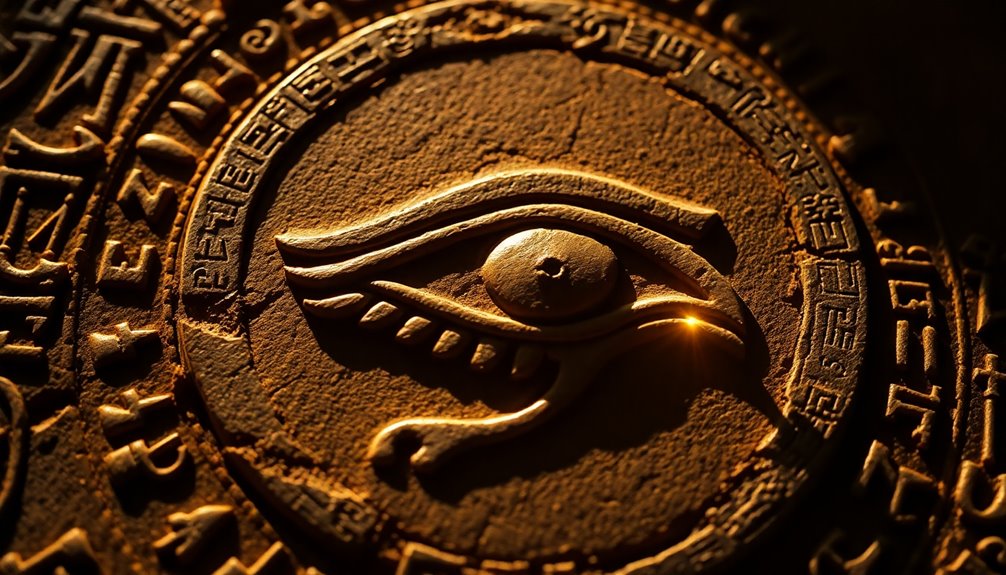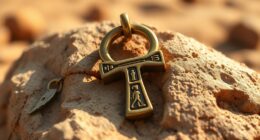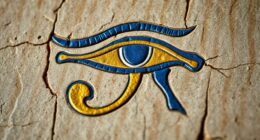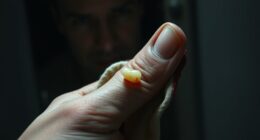To safeguard their names for eternity, ancient Egyptians enclosed their royal names in a cartouche, an oval-shaped symbol with a horizontal line. This sacred enclosure acted as a divine seal, guarding the name against evil spirits and oblivion. The shape and inscriptions reinforced the king’s divine authority and ensured their name remained un erased. If you want to discover how these symbols upheld divine power, keep exploring the fascinating details behind the cartouche’s significance.
Key Takeaways
- Royal names were inscribed within cartouches, oval shapes symbolizing divine protection and permanence.
- The cartouche’s shape acts as a divine seal, safeguarding the name from erasure or oblivion.
- Hieroglyphic inscriptions in cartouches were carefully preserved on temples, tombs, and official records.
- Enclosing the name within a cartouche created a powerful talisman against evil spirits and forgetting.
- Protecting the royal name was essential to maintain the pharaoh’s divine power and eternal life in the afterlife.
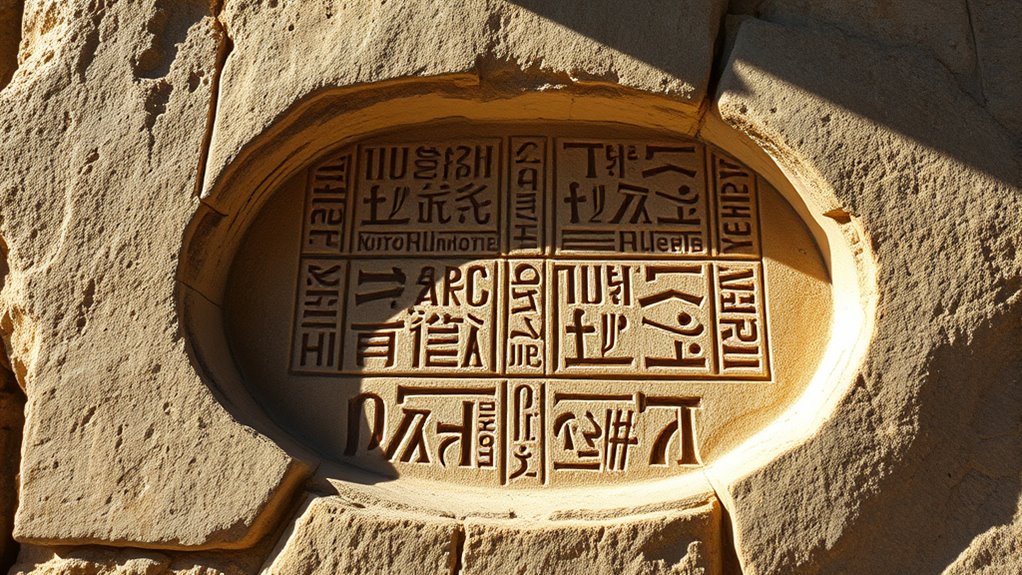
In ancient Egypt, safeguarding the names of royalty wasn’t just a matter of pride — it was believed to guarantee their everlasting existence in the afterlife. You’ll notice this importance reflected in the way royal names were carefully inscribed using hieroglyphic inscriptions. These inscriptions weren’t random symbols; they contained sacred words that held power, making the preservation of a king’s name essential to maintaining their divine status beyond death. When you examine ancient tombs or monuments, you’ll see that the royal titulary, the formal set of titles and names given to pharaohs, was prominently displayed within cartouches, which are oval-shaped enclosures. These cartouches served as a protective barrier, safeguarding the royal name from harm, decay, or desecration.
The hieroglyphic inscriptions inside the cartouche aren’t just decorative; they’re the very essence of the king’s identity and divine authority. Each hieroglyph in the royal titulary carries symbolic meaning, representing qualities like strength, stability, and divine favor. By enclosing these hieroglyphs within a cartouche, the ancient Egyptians believed they created a powerful talisman that kept the king’s name safe from evil spirits and oblivion. You might notice that the design of the cartouche resembles an elongated oval with a horizontal line at one end — a shape chosen deliberately to serve as a divine seal. This seal was more than artistic; it was a protective spell, ensuring that the king’s name wouldn’t be erased or forgotten.
Additionally, the use of hieroglyphic inscriptions within the cartouches reinforced the idea that the written word itself held sacred and protective qualities, vital for the eternal life of the pharaoh. As you study the hieroglyphic inscriptions, you’ll observe that the royal titulary often includes several names, each signifying different aspects of the king’s identity and divine role. The throne name, birth name, and throne title are all carefully inscribed within their respective cartouches, emphasizing the importance of each. The use of these cartouches in temples, tombs, and official inscriptions reinforced the idea that a king’s name was inherently linked to their eternal life force. If the name was lost or defaced, it was believed that the king’s power in the afterlife would diminish, which is why so much effort was made to protect and preserve these hieroglyphic inscriptions. Consequently, the cartouche became a symbol of divine permanence, embodying the ancient Egyptians’ unwavering belief in the everlasting nature of their pharaohs.
Frequently Asked Questions
How Did the Design of Cartouches Evolve Over Different Egyptian Dynasties?
You notice that the design of cartouches changed through Egyptian dynasties, reflecting shifts in hieroglyphic stylization and royal titulary evolution. Early cartouches are simple, oval shapes with straightforward hieroglyphs, but later periods feature more elaborate outlines and intricate details. These changes show how the Egyptians emphasized royal authority and identity, evolving their symbols to reinforce the divine status of the pharaohs across different eras.
Were Cartouches Used Exclusively for Pharaohs or for Other Officials?
You might think cartouches only held pharaohs’ names, but they also protected titles of other officials within the royal hierarchy. These inscriptions used symbolism to emphasize authority and divine right. By enclosing names in a cartouche, you show their importance and connection to the divine. So, while primarily for royalty, cartouches also served to honor high-ranking officials and reinforce their status through symbolic inscriptions.
What Materials Were Most Commonly Used to Inscribe Cartouches?
Did you know ancient engravers often used stone and precious metals for inscriptions? In cartouches, they favored materials like limestone, sandstone, and granite because of their durability. Ancient engraving techniques relied on chisels and abrasive tools, while material preservation methods guaranteed these inscriptions lasted thousands of years. You can see how these choices made royal names timeless, highlighting the Egyptians’ skill in combining artistry with practicality for eternity.
How Did the Discovery of Cartouches Influence Modern Egyptology?
You see, discovering cartouches revolutionized modern Egyptology by enhancing hieroglyph interpretation and improving royal identity preservation. These inscriptions provided clear clues to decipher ancient scripts, unsealing secrets of Egyptian culture. As a result, researchers could accurately identify pharaohs and understand their reigns. This breakthrough deepened our appreciation of Egypt’s history and made it easier to preserve royal legacies, ensuring these names remained eternal through careful study and preservation efforts.
Are There Any Known Cases of Cartouches Being Deliberately Altered or Erased?
Did you know that about 20% of ancient Egyptian cartouches show signs of hieroglyphic vandalism? Yes, some cartouches were deliberately altered or erased, often during political upheaval or to undermine a ruler’s legacy. Modern archaeologists perform cartouche restoration to fix these damages, but cases of intentional erasure still surprise experts. These acts reveal the complex history of political shifts and the ongoing struggle to preserve Egypt’s ancient heritage.
Conclusion
Just as the cartouche safeguarded a pharaoh’s eternal legacy, it reminds you that names hold power beyond life. Like a timeless inscription carved into history’s stone, your words and legacy can echo through eternity. Embrace this timeless tradition, knowing your identity can be protected and revered just as ancient kings ensured their names endured forever. In the end, your name, like theirs, can become a symbol of lasting influence—an eternal mark on the sands of time.

